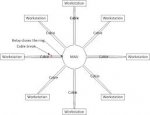Here are some practical suggestions you can use:
A patch panel is use to to connect multi fiber cable, say 6 or 12 count, to a jumper that goes to you switch.
Between your equipment cabinets, you can run jumper cable (think zip cord), they can be ordered preterminated which is what I recommend.
The jumper cable is pretty tough, but it may be best to run in 1" emt or orange smurf tube. Enter in the bottom of the cabients.
The advantage of a 6 or 12 count fiber is you have spares. A fiber circuit typically takes 2 fibers. Again I would recommend preterminated fiber, just measure and call Graybar Electric. The cables have nice pulling heads on them easy to pull in but limit the bends please in the conduit.
If you use a jumper you don't need a patch panel, the jumper will plug into your switch/router.
There are three types of connectors, ST, SC and LC. What you use depends on what you using it with.
There are two different types of fiber, mulitmode and single mode. Multimode is fine inside a building, single mode is for long distances. And multimode media convertors are less expensive.
Since you mentioned a ring, thats where you go from one panel to the next and back to the start. A ring takes a ring controller, as if all the cabinets are all connected in a ring the system won't work. A ring controller looks for a break and then routes the enet packets the other way,
There are many types of routers/switches. I prefer Rockwell Automation Stratix. Some of them are managed and have a lot of nice features, plus inside they are base on Cisco, which makes the IT folks happy. the startix is designed to mount in a control panel in DIN rail and is industrial rated. Most are 24 VDC
There is lots of good information at the Rockwell automation site and you should be able to get someone to help you, but I don't think Rockwell makes a ring controller. this encludes sample lay out drawings, etc.
Sixnet and Ntron are two companies that make industrial switches routers. N Tron got bought by Red Lion, I am not a big Red Lion fan, but go to there web pages and look under solutions,
https://www.redlion.net/n-tron .
I would call N tron and get some one to help you with product applications.
You need to determine
type of fiber, cable or jumper
multimode or single mode
type of connector
type of switch/router



